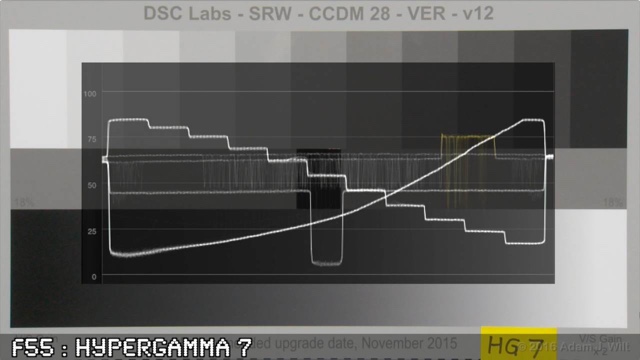In my V-Log L Revisited article, I went on at some length about neutral rendering across the tonal scale — how log capture preserves tonal relationships between brightness levels regardless of exposure settings, within reasonable limits. This consistent capture lets you adjust levels in post without materially affecting the look of the image, so that you can correct exposure without changing your grade. It’s one of the primary benefits of log capture.
What I didn’t do was show you what I was talking about. Sorry! Let’s fix that.
I aimed cameras at a DSC Labs Cine-ChromaDuMonde chart and recorded iris pulls in both gamma-encoded and log-encoded captures. I made waveform monitor renderings of those clips and superimposed ‘em on the clips themselves, so you can see exactly how the signals change as exposure varies.

The Cine-ChromaDuMonde has both a log-encoded ramp and a gamma-encoded 11-step grayscale, which makes it easy to see when log or gamma curves are in use: the 11-step grayscale descends in a straight line (more or less) in gamma-encoded captures, while the log ramp rises in a straight line (again, more or less) in log encodings. It’s a handy party trick, but don’t get hung up on it; for the purpose of this demo, just observe how the waveforms evolve as exposure changes.
I shot the first set of tests with a F55 two years ago, using a standard, Rec.709 gamma with a reasonably aggressive knee to compress highlights; Hypergamma 7, a gamma setting with a strong S-curve to preserve highlights; and both S-Log2 and S-Log3 log settings. The pulls were all from around f/16 up to the maximum aperture of around f/2 on the Canon broadcast zoom I was using.
I shot the second set with a GH4 this weekend, using the Natural photo style, a gamma with S-curved highlights; Cinelike D, which has a mild knee; and V-Log L, the GH4’s log setting. These pulls were from T22 to T2.8 on a Veydra 50mm T2.2.
Since V-Log L uses a constrained brightness range of 7%–80%, I stretched it in post to fill the 0%–100% range, so that the appearance range on the WFM is consistent with that of the gamma encodings. All I’ve done is boost contrast; I haven’t affected the shape of the waveform aside from that.
(If the video above doesn’t work, here’s a direct link: https://youtu.be/II4_uBWel_c)
More details: yes, all the curves show some compression in the shadows, even the log captures. There are two main reasons for this. First, preserving a true straight-line response down to the zero-signal level in either log or gamma encoding would require infinite amplifier gain, which is, um, somewhat difficult to do in the real world, so all cameras show some flattening of the signal in the very darkest parts of the image. Second, low-level noise in both the sensor and the analog amplifier keeps the signal from going completely to zero in any case. Both of these contribute to the “toe” of the signal, a flattening of the curves below ~10% or so depending on the camera and its capture setting.
You may have seen the outer edges of the F55’s waveforms bending down as the iris was opened all the way: a Canon broadcast zoom on a B4 adapter was used for those shots, and it shows some edge darkening or vignetting at maximum aperture.
On the GH4 clips, the flat lines for the 18% and 70% gray backgrounds sag slightly to either side due to my use of a single light on the chart from behind and above the camera instead of the more even illumination of two lights at 45º angles. My bad! The lens used — a Veydra 50mm T2.2 — is very flat edge-to-edge from T2.8 on down, where these tests were run.
The log ramp on this particular Cine-ChromaDuMonde chart has a very slight brightness dip in the middle and middle-right-side of the scale, so its waveform isn’t perfectly straight on any of the log waveforms.
And yes: the F55 shows a lot more highlight headroom in log modes than the GH4 does, and the GH4’s log is quite a bit noisier in the shadows than the F55’s. The F55’s 14 stops of dynamic range in log gives you considerably more room to shift exposure up and down without losing important highlight and shadow detail compared to the GH’s 12 stops, especially considering how noisy the shadows are in GH4’s log captures. But remember: the F55 costs more than $25,000, while the GH4 can be had for under $1,000. You do get what you pay for.
Disclosure: I bought my GH4s with my own money at market prices. The F55 was on loan from Sony while developing a presentation for Cine Gear Expo 2014. I have the DSC Labs Cine-ChromaDuMonde on a long-term loan. I’ve worked for DSC Labs and Sony at trade shows; aside from that there is no material relationship between me and any of the vendors mentioned.


